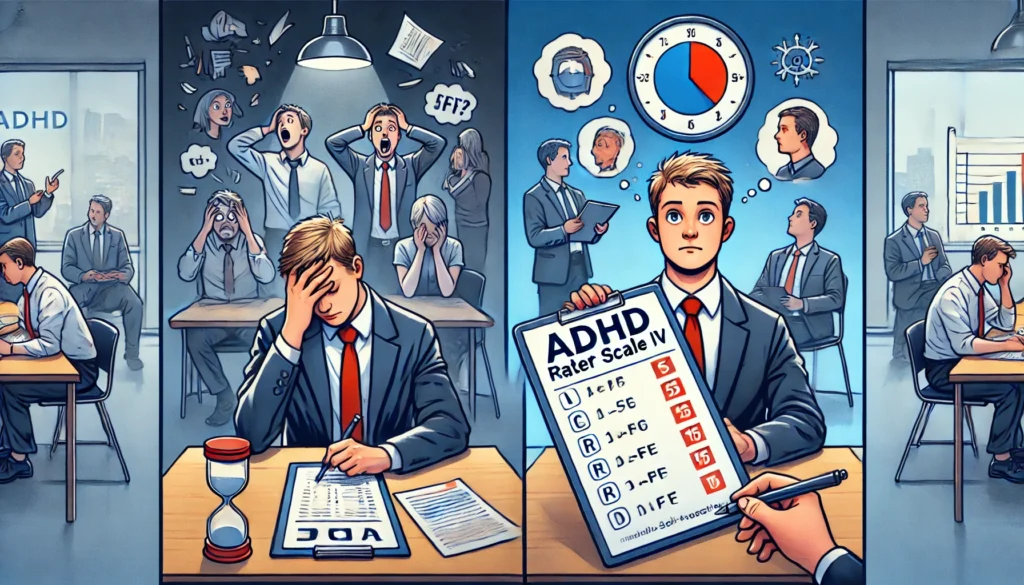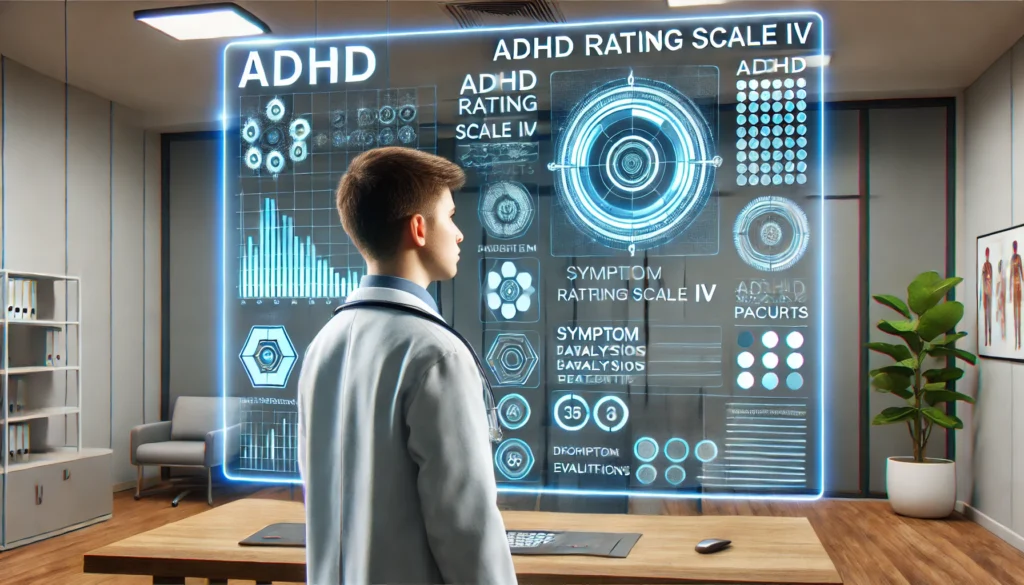The ADHD Rating Scale IV was developed as a response to the growing need for a standardized method to assess ADHD symptoms across different age groups. It builds upon previous versions by incorporating advances in our understanding of ADHD, ensuring a more nuanced approach to diagnosis.
You may also like: Enhancing Concentration: Strategies for ADHD
Historical Context
Historically, ADHD was primarily considered a childhood disorder, but research has shown that symptoms often persist into adulthood. This recognition highlighted the necessity for an assessment tool that could accurately diagnose ADHD across the lifespan, leading to the creation of the ADHD RS IV.
Evolution of the Scale
The ADHD Rating Scale has undergone several revisions to incorporate the latest research findings. Each version has improved upon the last by including more specific criteria and prompts that align with current scientific understanding. This evolution reflects a commitment to improving diagnostic accuracy and patient outcomes.
Inclusion of Adult Prompts
The inclusion of adult prompts in the ADHD RS IV was a pivotal advancement. These prompts are tailored to capture the subtle and often overlooked manifestations of ADHD in adults, who may have developed coping strategies that mask their symptoms. This adaptation makes the ADHD RS IV a versatile tool for assessing individuals of all ages.
Structure and Content of the ADHD Rating Scale IV
The ADHD RS IV consists of two primary components: inattention and hyperactivity-impulsivity, each containing nine items. These items are rated on a four-point scale, ranging from “never or rarely” to “very often,” based on the frequency of the symptoms observed.
Inattention
The inattention component evaluates symptoms such as difficulty sustaining attention, lack of follow-through on tasks, and forgetfulness. These symptoms can significantly impact an adult’s professional and personal life, making accurate assessment crucial.
Symptom Breakdown
The inattention items are carefully curated to reflect common challenges faced by individuals with ADHD. These include difficulties with organization, avoiding tasks requiring sustained mental effort, and frequent daydreaming. Each symptom is explored through specific prompts, ensuring a thorough evaluation.
Impact on Daily Life
Inattention can affect various aspects of an adult’s life, from job performance to personal relationships. Understanding these impacts is essential for developing effective management strategies. The ADHD RS IV prompts help identify areas where intervention may be needed, highlighting how inattention can disrupt daily routines and responsibilities.
Strategies for Addressing Inattention
Once inattention symptoms are identified, targeted strategies can be implemented to mitigate their effects. These may include cognitive-behavioral techniques, organizational tools, and environmental modifications. The ADHD RS IV serves as a guide for tailoring interventions to the unique needs of each individual.
Hyperactivity-Impulsivity
The hyperactivity-impulsivity component assesses symptoms like restlessness, difficulty waiting for one’s turn, and interrupting others. These behaviors can lead to challenges in social and occupational settings.
Behavioral Analysis
The hyperactivity-impulsivity items are designed to capture a range of behaviors that may interfere with an individual’s ability to function effectively in various environments. The scale considers both overt and subtle manifestations, providing a comprehensive picture of the individual’s experience.
Social and Occupational Implications
Hyperactivity and impulsivity can strain social interactions and professional relationships. These symptoms may result in misunderstandings or conflicts if not properly managed. By identifying these challenges through the ADHD RS IV, individuals can develop strategies to improve their social and occupational functioning.
Management Techniques
Managing hyperactivity and impulsivity often involves behavioral interventions and lifestyle adjustments. Techniques such as mindfulness, structured routines, and physical activity can be beneficial. The ADHD RS IV helps guide the selection of appropriate strategies based on the individual’s symptom profile.

The Role of Adult Prompts in the ADHD Rating Scale IV
The addition of adult prompts to the ADHD RS IV addresses the unique presentation of ADHD symptoms in adults. Unlike children, adults often develop coping mechanisms that mask their symptoms, making traditional assessment methods less effective.
Tailored Assessment
Adult prompts are designed to elicit responses that reflect the adult experience of ADHD. For example, questions may focus on workplace performance, relationship dynamics, and self-management skills, providing a comprehensive view of how ADHD manifests in adult life.
Workplace Context
In the workplace, ADHD symptoms can manifest in unique ways. Adult prompts in the ADHD RS IV explore issues such as time management, meeting deadlines, and maintaining focus during meetings. These questions help illuminate how ADHD may affect an individual’s professional capabilities and identify areas for improvement.
Relationship Dynamics
ADHD can influence personal relationships, often creating misunderstandings or conflicts. The scale’s prompts delve into how symptoms like impulsivity and inattentiveness impact communication and emotional connections. This insight is crucial for developing strategies to enhance relationship satisfaction.
Self-Management Skills
Adults with ADHD may struggle with self-management, leading to difficulties in maintaining routines and achieving personal goals. The ADHD RS IV’s adult prompts help assess these challenges, offering a foundation for interventions aimed at improving self-regulation and organization.
Enhanced Accuracy
By incorporating adult prompts, the ADHD RS IV allows for a more accurate diagnosis, paving the way for targeted interventions. This is particularly important as untreated ADHD in adults can lead to issues such as anxiety, depression, and substance abuse.
Diagnostic Precision
The tailored nature of adult prompts enhances the precision of ADHD diagnoses. By focusing on adult-specific symptoms and scenarios, the scale reduces the likelihood of misdiagnosis and ensures that individuals receive appropriate treatment.
Pathway to Effective Interventions
A precise diagnosis is the first step toward effective intervention. With a clear understanding of an individual’s symptom profile, clinicians can develop personalized treatment plans that address specific challenges, reducing the risk of comorbid conditions.
Long-Term Benefits
Accurate assessment and targeted interventions can significantly improve an individual’s quality of life. By addressing ADHD symptoms, adults can experience better mental health, enhanced relationships, and improved professional performance, leading to long-term well-being.

Implementing the ADHD Rating Scale IV in Practice
The practical application of the ADHD RS IV requires a thoughtful approach. Here are some considerations for health professionals:
Understanding the Context
When administering the ADHD RS IV, it’s essential to consider the individual’s environment and life circumstances. Stress, lifestyle, and co-existing conditions can all influence ADHD symptoms, and these factors should be taken into account when interpreting results.
Environmental Influences
The environment plays a crucial role in the presentation of ADHD symptoms. Factors such as work demands, home life, and social settings can exacerbate or mitigate symptoms. Understanding these influences helps in contextualizing the results and tailoring interventions accordingly.
Lifestyle Considerations
An individual’s lifestyle, including diet, exercise, and sleep patterns, can impact ADHD symptoms. Health professionals should consider these aspects when assessing ADHD, as lifestyle modifications may be a key component of the treatment plan.
Co-existing Conditions
Many adults with ADHD have co-existing conditions, such as anxiety or depression, which can complicate diagnosis and treatment. Recognizing these comorbidities is essential for developing a comprehensive management strategy that addresses all aspects of the individual’s health.
Collaborative Approach
Involving the individual in the assessment process can enhance the accuracy of the evaluation. Encourage open communication about their experiences, and consider using additional tools, such as self-reported questionnaires or input from family members, to gain a well-rounded perspective.
Patient Engagement
Active patient involvement in the assessment process fosters a sense of ownership and collaboration. Encouraging individuals to share their experiences and perspectives can lead to more accurate assessments and a stronger therapeutic alliance.
Use of Complementary Tools
Supplementing the ADHD RS IV with additional assessment tools can provide a more complete picture of an individual’s symptoms. Self-reported questionnaires and input from close contacts offer valuable insights that enhance the overall evaluation process.
Family and Social Support
Incorporating feedback from family members and close friends can provide additional context to the assessment. These individuals can offer observations that the patient may overlook, contributing to a more comprehensive understanding of the symptoms and their impact.
Ongoing Evaluation
ADHD is a dynamic condition, and symptoms can fluctuate over time. Regular assessments using the ADHD RS IV can help track changes in symptoms and the effectiveness of interventions, allowing for adjustments to be made as needed.
Monitoring Symptom Changes
Regular use of the ADHD RS IV enables clinicians to monitor changes in symptom severity and presentation over time. This ongoing evaluation is critical for ensuring that treatment remains effective and aligned with the individual’s evolving needs.
Adjusting Interventions
As symptoms fluctuate, treatment plans may require adjustments. The ADHD RS IV provides a framework for assessing the effectiveness of interventions and making necessary changes to optimize outcomes.
Longitudinal Care
ADHD management is a lifelong process, and the ADHD RS IV supports longitudinal care by facilitating continuous assessment and adaptation of treatment strategies. This approach ensures sustained improvement and well-being for individuals with ADHD.

Current Trends and Future Implications
The field of ADHD research is continually evolving, with new insights and technologies shaping the way we understand and manage the disorder.
Emerging Technologies
Advancements in digital health technologies, such as mobile apps and wearable devices, are beginning to complement traditional assessment tools like the ADHD RS IV. These technologies offer real-time data on symptom patterns and treatment effectiveness, potentially enhancing the precision of ADHD management.
Digital Health Innovations
Mobile apps designed for ADHD management offer features such as symptom tracking, medication reminders, and cognitive exercises. These tools provide individuals with immediate feedback and support, augmenting traditional assessment methods.
Wearable Devices
Wearable technology, such as smartwatches, can monitor physiological indicators related to ADHD, such as heart rate variability and sleep patterns. This data can offer insights into the relationship between physiological states and ADHD symptoms, informing more personalized treatment approaches.
Integration with Traditional Tools
The integration of digital technologies with traditional assessment tools like the ADHD RS IV can enhance the overall diagnostic process. By combining real-time data with structured assessments, clinicians can achieve a more comprehensive understanding of the individual’s condition.
Personalized Interventions
As our understanding of ADHD deepens, there is a growing emphasis on personalized interventions. Tailored strategies that consider an individual’s unique symptom profile, lifestyle, and goals are increasingly being recognized as effective approaches to managing ADHD in adults.
Customizing Treatment Plans
Personalized interventions involve creating treatment plans that address the specific needs and preferences of the individual. This approach can include a combination of medication, therapy, lifestyle changes, and support systems, ensuring a holistic treatment strategy.
Lifestyle and Environmental Modifications
Lifestyle changes, such as diet and exercise, along with environmental modifications, can significantly impact ADHD symptoms. Personalized interventions often incorporate these elements to create a supportive environment that enhances treatment efficacy.
Goal-Oriented Strategies
Developing goal-oriented strategies empowers individuals with ADHD to focus on achieving specific objectives. This approach fosters motivation and engagement, leading to improved adherence to treatment plans and better outcomes.
Conclusion
The ADHD Rating Scale IV is a valuable tool in the assessment and management of ADHD, particularly with its inclusion of adult prompts. By providing a detailed and comprehensive evaluation of symptoms, it empowers health professionals to deliver targeted interventions that can significantly improve the quality of life for individuals with ADHD.
For health and wellness coaches, science journalists, and biohackers alike, understanding the nuances of the ADHD RS IV can enhance the ability to offer informed, practical advice and insights. As the landscape of ADHD research continues to evolve, staying informed about these developments will be essential in supporting those affected by this complex disorder.
Empowering Health Professionals
The ADHD RS IV equips health professionals with the tools needed to accurately assess and manage ADHD. By understanding the intricacies of this scale, practitioners can offer more effective care and support to their patients.
Advancing Research and Education
Continued research and education on ADHD and assessment tools like the ADHD RS IV are crucial for advancing the field. By staying informed and engaged with the latest developments, professionals can contribute to the ongoing improvement of ADHD management strategies.
Supporting Individuals with ADHD
Ultimately, the goal of the ADHD RS IV and related research is to support individuals with ADHD in leading fulfilling lives. By providing accurate assessments and personalized interventions, health professionals can help individuals with ADHD achieve their potential and improve their overall well-being.
Further Reading:
ADHD Rating Scales: What You Need to Know
Screening & Assessment Tools for the Pediatric Practice
Important Note: The information contained in this article is for general informational purposes only, and should not be construed as health or medical advice, nor is it intended to diagnose, prevent, treat, or cure any disease or health condition. Before embarking on any diet, fitness regimen, or program of nutritional supplementation, it is advisable to consult your healthcare professional in order to determine its safety and probable efficacy in terms of your individual state of health.
Regarding Nutritional Supplements Or Other Non-Prescription Health Products: If any nutritional supplements or other non-prescription health products are mentioned in the foregoing article, any claims or statements made about them have not been evaluated by the U.S. Food and Drug Administration, and such nutritional supplements or other health products are not intended to diagnose, treat, cure, or prevent any disease.


